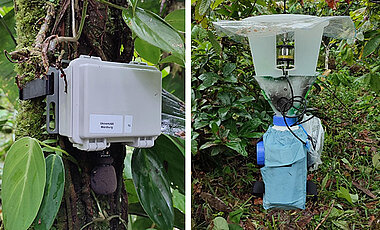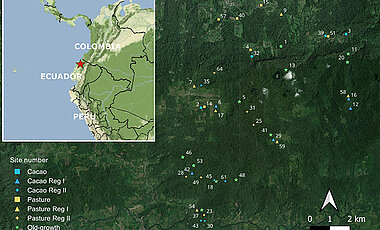AI Models Identify Biodiversity in Tropical Rainforests
10/17/2023Animal sounds are a very good indicator of biodiversity in tropical reforestation areas. Researchers led by Würzburg Professor Jörg Müller demonstrate this by using sound recordings and AI models.

Tropical forests are among the most important habitats on our planet. They are characterised by extremely high species diversity and play an eminent role in the global carbon cycle and the world climate. However, many tropical forest areas have been deforested and overexploitation continues day by day.
Reforested areas in the tropics are therefore becoming increasingly important for the climate and biodiversity. How well biodiversity develops on such areas can be monitored very well with an automated analysis of animal sounds. This was reported by researchers in the journal Nature Communications.
Recordings on Former Cocoa Plantations and Pastures
As part of the DFG research group Reassembly, the team worked in northern Ecuador on abandoned pastures and former cacao plantations where forest is gradually reestablishing itself. There, they investigated whether autonomous sound recorders and artificial intelligence (AI) can be used to automatically recognise how the species communities of birds, amphibians and mammals are composed.
"The research results show that the sound data reflect excellently the return of biodiversity in abandoned agricultural areas," Professor Jörg Müller is pleased to say. The head of the Ecological Station Fabrikschleichach at Julius-Maximilians-Universität (JMU) Würzburg and his colleague Oliver Mitesser were in charge of the study.
Overall it is particularly the communities of vocalizing species that mirrors the recolonisation very well – because the communities follow strictly the recovery gradients. A preliminary set of 70 AI bird models was able to describe the entire species communities of birds, amphibians and some calling mammals. Even the changes in nocturnal insects could be meaningfully correlated with them.
Download: audio file with animal voices from the rainforest
AI Models are Being Further Refined
The team is currently working on further improving the AI models used and expanding the set of models. The goal is to be able to automatically record even more species. The models are also to be established in other protected areas in Ecuador, the Sailershausen JMU Forest and in Germany's oldest national park in the Bavarian Forest.
"Our AI models can be the basis for a very universal tool for monitoring biodiversity in reforested areas," says Jörg Müller. The Würzburg professor sees possible applications, for example, in the context of certifications or biodiversity credits. Biodiversity credits function similarly to carbon dioxide emissions trading. They are issued by projects that protect or improve biodiversity. They are purchased by companies or organisations that want to compensate for negative impacts of their activities.
Sponsors and Participants
The study was realised within the framework of the research group Reassembly, which is funded by the German Research Foundation (DFG).
In addition to the JMU researchers, the ornithologist Dr. Martin Schaefer, managing director of the nature conservation foundation Jocotoco, and Professor Nico Blüthgen from the Technical University of Darmstadt – who is the spokesperson of the DFG research group and a JMU alumnus – were also involved. Sound expert Professor Zuzana Burivalova from the University of Madison (USA) and the company Rainforest Connection, which specialises in AI models for tropical bird detection, also contributed.
Publication
Soundscapes and deep learning enable tracking biodiversity recovery in tropical forests. Nature Communications, 17 October 2023, DOI: 10.1038/s41467-023-41693-w
Contact person
Prof. Dr. Jörg Müller, University of Würzburg, joerg.mueller@uni-wuerzburg.de








